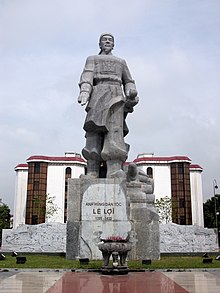Lê Lợi
| Lê Lợi | |||||||||
|---|---|---|---|---|---|---|---|---|---|
| Emperor of Đại Việt | |||||||||

Lê Lợi statue in front of the Municipal Hall of Thanh Hóa Province, the place of his birth
|
|||||||||
| Reign | 1428–1433 | ||||||||
| Predecessor | None | ||||||||
| Successor | Lê Thái Tông | ||||||||
| Born | 10 September 1384/1385 | ||||||||
| Died | 5 September 1433 | ||||||||
| Burial | Vinh Tomb, Lam Sơn | ||||||||
| Issue | Le Tu Te Lê Thái Tông |
||||||||
|
|||||||||
| House | Lê dynasty | ||||||||
| Father | Le Khoang | ||||||||
| Mother | Trịnh Thi Ngoc Thuong | ||||||||
| Full name | |
|---|---|
| Lê Lợi | |
| Temple name | |
| Thai To |
| Lê Lợi | |
| Vietnamese name | |
|---|---|
| Vietnamese | Lê Lợi |
| Hán-Nôm | |
| Birth name |
Lê Lợi (1384 or 1385? – 1433), posthumously known by his temple name Lê Thái Tổ, was emperor of Vietnam and founder of the Later Lê dynasty. Lê Lợi is among the most famous figures of Vietnamese history and one of its greatest heroes.
Lê Lợi was the youngest of three sons. His father was an aristocratic nobleman in Lam Sơn (northern-Vietnam). The town was in a newly colonized area of Vietnam which would eventually be called Thanh Hóa Province. Lam Son had been established by Lê Lợi's great-grandfather Le Hoi sometime in the 1330s. His exact date of birth is not certain, but 1384 is generally agreed on by historians. Lam Son was on the frontier of Vietnam, as a result it was further and hence more free from government control.
This was a troubled time in Vietnam's history as the Hồ dynasty in 1400 finally displaced the Trần dynasty and set about reforming the kingdom. Hồ rule was short lived as members of the Trần dynasty petitioned for intervention from the Yongle Emperor of the Chinese Ming Empire to the north. He responded by sending a powerful army south into Vietnam and vanquished the Hồ. Upon failing to find a Trần heir, the Ming government chose to re-establish sovereignty over Vietnam, as was the case in the days of the Tang dynasty, some 500 years previously.
The Ming government enjoyed some support from the Vietnamese, at least in the capital of Thăng Long but their efforts to assert control in the surrounding countryside were met with stiff resistance. The Vietnamese claim that the Ming military stole valuable artifacts from Vietnam such as gems, jade, golden pieces of art as well as books. Lê Lợi himself said that he chose the path of revolt against China's brutal government when he personally witnessed the destruction of a Vietnamese village by Ming forces.
...
Wikipedia
